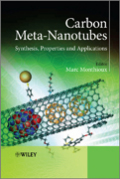
The book will present different chapters corresponding to each of the meta-nanotube categories. There will be an introductory chapter that will provide thebasics of what is needed to be known about pristine nanotubes to understand what is in the subsequent chapters. Each of the chapters that follow the introductory chapter will cover aspects from synthesis to applications, characterization, behavior, properties, and mechanisms. These chapters will focus on heterogeneous nanotubes, doped nanotubes, functionalized nanotubes, coated nanotubes and hybrid nanotubes, respectively, and will be followed by a final concluding chapter. INDICE: List of Contributors xiii Foreword xv List of Abbreviations xvii Acknowledgements xxi Introduction to the Meta-Nanotube Book 1 Marc Monthioux 1 Time for a Third-Generation of Carbon Nanotubes 1 2 Introducing Meta-Nanotubes2 2.1 Doped Nanotubes (X:CNTs) 3 2.2 Functionalized Nanotubes (X-CNTs) 3 2.3 Decorated (Coated) Nanotubes (X /CNTs) 3 2.4 Filled Nanotubes (X@CNTs) 3 2.5 Heterogeneous Nanotubes (X*CNTs) 4 3 Introducing the Meta-Nanotube Book 4 References 5 1 Introduction to Carbon Nanotubes 7 Marc Monthioux 1.1 Introduction 71.2 One Word about Synthesizing Carbon Nanotubes 7 1.3 SWCNTs: The Perfect Structure 11 1.4 MWCNTs: The Amazing (Nano)Textural Variety 18 1.5 Electronic Structure 29 1.6 Some Properties of Carbon Nanotubes 31 1.7 Conclusion 36 References 36 2 Doped Carbon Nanotubes: (X:CNTs) 41 Alain Pénicaud, Pierre Petit andJohn E. Fischer 2.1 Introduction 41 2.1.1 Scope of this Chapter 41 2.1.2 A Few Definitions 42 2.1.3 Doped/Intercalated Carbon Allotropes a Brief History 432.1.4 What Happens upon Doping SWCNTs? 48 2.2 n-Doping of Nanotubes 52 2.2.1 Synthetic Routes for Preparing Doped SWCNTs 52 2.2.2 Crystalline Structure andChemical Composition of n-Doped Nanotubes 54 2.2.3 Modification of the Electronic Structure of SWCNTs upon Doping 59 2.2.4 Electrical Transport in Doped SWCNTs 61 2.2.5 Spectroscopic Evidence for n-Doping 65 2.2.6 Solutions of Reduced Nanotubes 72 2.3 p-Doping of Carbon Nanotubes 73 2.3.1 p-Doping of SWCNTs with Halogens 74 2.3.2 p-Doping with Acceptor Molecules 80 2.3.3 p-Doping of SWCNTs with FeCl3 84 2.3.4 p-Doping of SWCNTs with SOCl2 87 2.3.5 p-Doping of SWCNTs with Acids 87 2.3.6 p-Doping of SWCNTs with Superacids 91 2.3.7 p-Doping with other Oxidizing Agents 95 2.3.8 Diameter Selective Doping 96 2.4 PracticalApplications of Doped Nanotubes 99 2.5 Conclusions, Perspectives 100 References 101 3 Functionalized Carbon Nanotubes (X-CNTs) 113 Stéphane Campidelli, Stanislaus S. Wong and Maurizio Prato 3.1 Introduction 113 3.2 Functionalization Routes 113 3.2.1 Noncovalent Sidewall Functionalization of SWCNTs 114 3.2.2 Covalent Functionalization of SWCNTs 114 3.3 Properties and Applications 125 3.3.1 Electron Transfer Properties and Photovoltaic Applications 125 3.3.2 Chemical Sensors (FET-Based) 137 3.3.3 Opto-Electronic Devices (FET-Based) 139 3.3.4Biosensors 145 3.4 Conclusion 149 References 150 4 Decorated (Coated) Carbon Nanotubes (X/CNTs) 163 Revathi R. Bacsa and Philippe Serp 4.1 Introduction 1634.2 Metal-Nanotube Interactions Theoretical Aspects 166 4.2.1 Curvature-Induced Effects 168 4.2.2 Effect of Defects and Vacancies on the Metal-Graphite Interactions 169 4.3 Carbon Nanotube Surface Activation 170 4.4 Methods for Carbon Nanotube Coating 171 4.4.1 Deposition from Solution 171 4.4.2 Self-Assembly Methods 178 4.4.3 Electro- and Electrophoretic Deposition 183 4.4.4 Depositionfrom Gas Phase 187 4.4.5 Nanoparticles Decorating Inner Surfaces of Carbon Nanotubes 190 4.5 Characterization of Decorated
- ISBN: 978-0-470-51282-1
- Editorial: John Wiley & Sons
- Encuadernacion: Cartoné
- Páginas: 464
- Fecha Publicación: 30/12/2011
- Nº Volúmenes: 1
- Idioma: Inglés
